
Consultation hotline
SERVICE BUSINESS
服务业务
Intelligent pipe network solution
Intelligent pipe network solution
The water pipeline has a long distance and a complicated natural environment along the way. The pipeline is a double pipeline. In order to monitor the operation of pipelines, conduct real-time monitoring of external intrusions and pipeline leaks, and regularly detect pipeline settlements to ensure the normal and good operation of water pipelines, two distributed optical fiber monitoring systems need to be deployed to monitor the operating conditions of the entire pipeline. The system has the following functions:
Distributed leakage and intrusion monitoring
Real-time online monitoring
Leak point positioning
Leakage assessment
Intrusion point location
Intrusion event identification
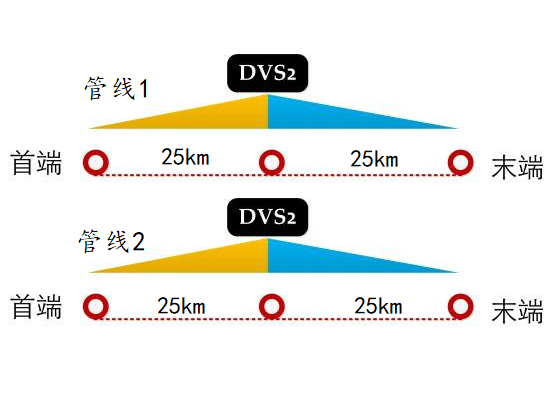
Specifically, two sets of dual-channel DVS systems can be used to radiate from the middle to both sides to achieve full coverage monitoring of 50km dual pipelines. In order to reduce the cost of system construction, fiber optic sensors can be installed in all two pipelines, and the two sets of sensors share a DVS system for time-sharing measurement, that is, only one pipeline can be monitored at the same time, and pipeline 1 and pipeline 2 are monitored in turn.
1 Introduction
The optical fiber pipeline leakage monitoring and safety early warning system adopts the latest distributed optical fiber disturbance sensing technology (φ-OTDR & MZI), which can detect the medium of long-distance (10~50km) water pipeline, crude oil/product pipeline, and natural gas pipeline Online monitoring of harmful events such as leakage, third-party construction and excavation, shield tunneling, man-made intrusion and destruction, landslides, and mudslides. When a harmful event occurs, the system can immediately alarm and locate it, helping the operating unit to quickly locate the hidden danger location, eliminate dangerous factors, and avoid loss of life and property and environmental pollution. The optical fiber pipeline leakage monitoring and safety early warning system uses the accompanying optical cable laid in the same trench as the pipeline or attached to the wall as the sensing optical cable to sense vibration and sound in the environment along the pipeline. The sensing optical fiber in the sensing optical cable should be SMF-28e standard single-mode optical fiber, which is a commonly used communication optical fiber at present. The optical fiber pipeline leakage monitoring and safety early warning system is based on the optical signal transmitted in the sensing optical cable, and continuously collects vibration and sound data for tens of kilometers along the pipeline, and conducts real-time and online analysis of these data to capture anomalies in the massive data. A sensing optical cable not only replaces thousands of linearly arranged acoustic sensors, but also eliminates the complicated and tedious wiring, power supply, anti-corrosion, electromagnetic shielding and other tasks when traditional point-type acoustic sensors are reused on a large scale. Low construction and maintenance costs. Due to the passive, flexible and stable characteristics of the optical fiber itself, the optical fiber pipeline leakage monitoring and safety early warning system has the advantages of natural resistance to chemical corrosion, anti-electromagnetic interference, no need for power supply, and simple installation. It is a long-distance linear space continuous physical field monitoring Recommended choice.
2. Application scenarios
2.1 Intrusion warning

Monitor those external intrusions that may threaten the safe operation of the pipeline, such as third-party construction and excavation. Carry out alarming, positioning, and event type analysis at the first time when an intrusion event occurs, helping owners to eliminate potential safety hazards in time.
2.2 Leak monitoring
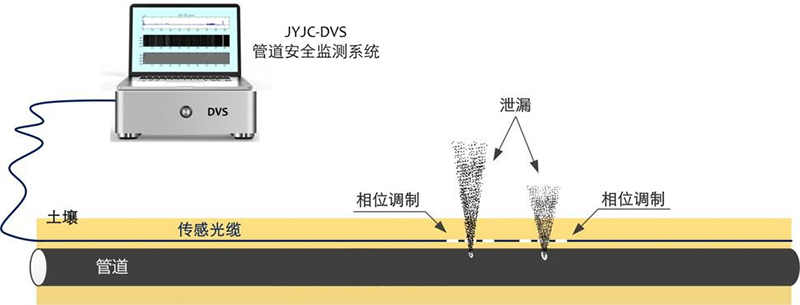
Monitor possible leaks across the pipeline, including sudden leaks and continuous leaks. Locate the leakage point and conduct online assessment of leakage. Help owners quickly lock leaks and reduce leakage.
2.3 Settlement measurement

According to the needs of the owner, the pipeline settlement can be regularly measured to determine whether there is an abnormal settlement pipe section, and the degree and location of the abnormal settlement can be analyzed and evaluated.
3. System composition
The distributed optical fiber pipeline leakage monitoring and safety early warning system is mainly composed of ①DVS host, ②display, keyboard, mouse and other interactive equipment, and ③sensing optical cable, as shown in the figure below.
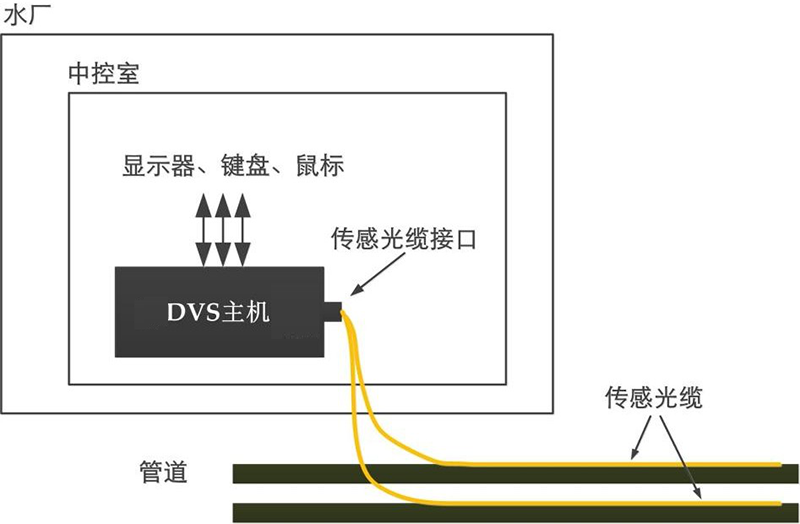
Place the DVS host in the central control room (or similar equipment room) of the water plant, and connect the monitor, keyboard, and mouse to 220V AC mains and turn it on for normal operation. Lead the sensor optical cable pasted along the pipe wall from the underground pipeline into the water plant and into the central control room. After selecting one core of the optical cable and fusing the FC/APC jumper, insert it into the sensor optical cable interface of the DVS host. Run the DVS leakage online monitoring software, the system is running normally, real-time online monitoring of leakage in various places in the pipeline.
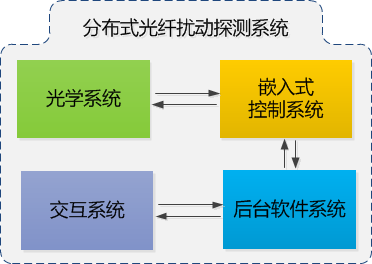
DVS functionally includes 4 subsystems, namely optical system, embedded control system, background software system and interactive system, as shown in the figure above.
The optical system generates a detection pulse with a very narrow line width and appropriate power. The detection pulse is injected into the sensing fiber and at the same time it receives the Rayleigh backscattered light returned from the sensing fiber, performs photoelectric conversion, and provides the original disturbance sensing signal. The embedded control system and the background software system store, process, calculate, transmit and interact with sensor data. The embedded control system converts the analog disturbance sensing signal output by the light detector into a digital signal through the data acquisition device, and delivers it to the background software system for real-time processing. After the background software system reads the sensor data, it performs preprocessing, filtering, batch FFT analysis, feature quantity calculation, threshold analysis, etc., to provide the processing results of the disturbance data. The interactive system displays the processing results of the background software system to the user in real time, including alarm information, disturbance curves, time-domain waveforms, spatio-temporal waterfall diagrams, access to historical alarm records, historical waveforms, and other functions, and can be used according to user input. The system's spatial resolution, pulse repetition frequency, detection pulse width and other parameters should be adjusted appropriately.
During the operation of the DVS, new disturbance monitoring data are continuously generated from the sensor optical cable. These monitoring data are continuously collected, processed, and analyzed, and finally the real-time evaluation results of the disturbance in the monitoring area are obtained. The life cycle of the data flow is shown in the figure below.
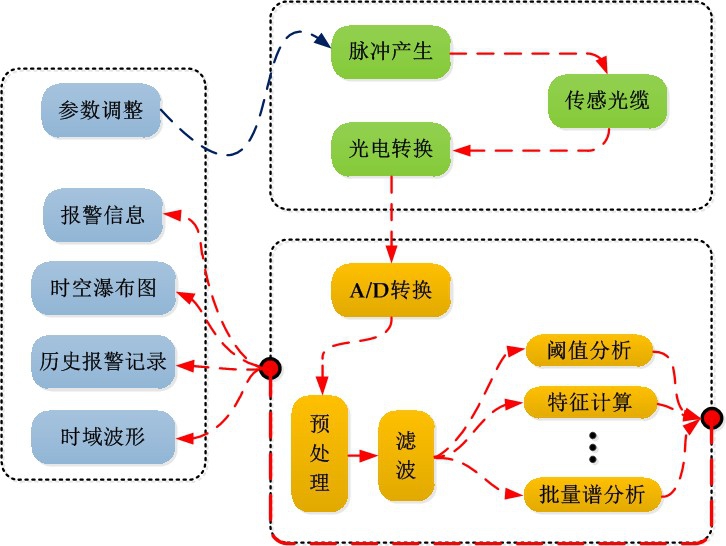
Contact
Add:No.3, longzhida Road, electronic industrial park, high tech Industrial Development Zone, Chengde City, Hebei Province
Hotline: 15930084101
After-sales installation: 0314-7018122 18603149003
Product inquiry purchase: 15930084101
After-sales maintenance: 18603149003
E-mail:310540860@qq.com
Website: www.cdlong.com

Enter mobile website
Copyright© Chengde longzhida Intelligent Instrument Technology Co., Ltd


